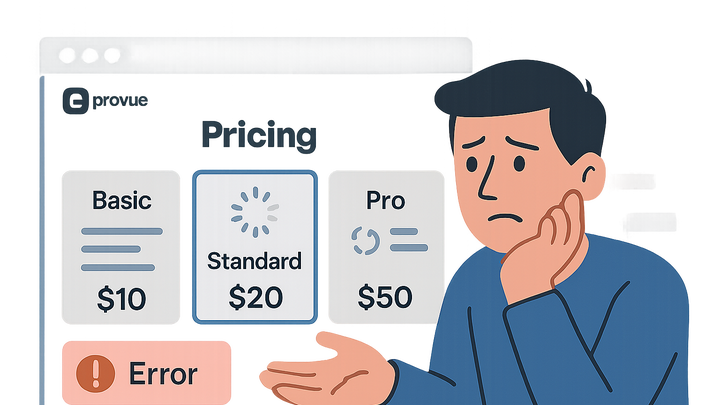Published on 2025-06-29T20:54:58Z
What is Plan Switch Friction? Examples and Best Practices
Plan Switch Friction refers to the resistance or obstacles that users face when attempting to change their subscription tier or pricing plan on a website. This friction may arise from complex user interfaces, unclear instructions, technical errors, or excessive steps. In the context of CRO (Conversion Rate Optimization), UX (User Experience), and SEO (Search Engine Optimization), high plan switch friction can lead to lower conversion rates, increased abandonment, and negative SEO signals such as reduced session duration. By diagnosing and reducing these friction points, businesses can streamline the switch process, enhance user satisfaction, and maximize lead generation. Tools like PreVue.me provide actionable critiques across CRO, lead generation, UX, SEO, and accessibility, helping you identify friction hotspots and implement targeted improvements.
Plan switch friction
User resistance during pricing plan changes due to UI or technical obstacles, harming CRO, UX, and SEO.
Understanding Plan Switch Friction
An overview of what plan switch friction is, why it occurs, and its impact on business metrics.
-
Definition and scope
What plan switch friction entails and the perspectives through which you can view it.
- Cro perspective:
Smooth plan changes can significantly boost conversion rates by reducing drop-offs.
- Ux perspective:
Intuitive transitions and clear CTAs enhance satisfaction and reduce confusion.
- Seo perspective:
Lower abandonment and higher engagement send positive signals to search engines.
- Cro perspective:
-
Common causes
Typical reasons why users face friction during plan switches.
- Complex ui flows:
Multi-step forms and hidden options can confuse users.
- Lack of feedback:
Users need clear confirmations and status updates to feel confident.
- Pricing ambiguity:
Unclear price differences and billing terms create hesitation.
- Complex ui flows:
-
Business impact
How friction affects conversion, revenue, and SEO performance.
- Increased abandonment:
Users drop off when the process feels overly complicated or slow.
- Lost revenue opportunities:
Every friction point can reduce upsell and cross-sell potential.
- Negative seo signals:
High bounce rates and low session duration can hurt rankings.
- Increased abandonment:
Measuring Plan Switch Friction
Key metrics to quantify and track the level of friction in your plan switching process.
-
Time to switch (tts)
The average time it takes for users to complete the plan switch process from start to finish.
- Benchmarking:
Compare TTS across segments to identify slow user groups.
- Goal setting:
Set target TTS to push for streamlined flows.
- Benchmarking:
-
Error rate
The percentage of plan switch attempts that fail due to errors or technical issues.
- Client-side errors:
Form validation and browser compatibility issues.
- Server-side errors:
API timeouts and billing engine failures.
- Client-side errors:
-
Completion rate
The proportion of users who successfully switch plans out of those who initiate the process.
- Funnel analysis:
Identify drop-off steps with the highest abandonment.
- Segmentation:
Analyze completion by device, browser, or user intent.
- Funnel analysis:
Strategies to Reduce Plan Switch Friction
Best practices and tactics to minimize resistance and improve conversion during plan changes.
-
Simplify the user interface
Design intuitive layouts with clear plan comparisons and minimal clicks.
- Single-step switch:
Allow users to change plans without leaving the page.
- Visual clarity:
Use highlighting and color-coding to differentiate plans.
- Single-step switch:
-
Provide real-time feedback
Keep users informed about progress, confirmations, and errors instantly.
- Progress indicators:
Use spinners or progress bars to show loading states.
- Inline validation:
Validate inputs before form submission to catch errors early.
- Progress indicators:
-
Leverage automation and prefill
Reduce manual input by auto-filling known data and offering smart suggestions.
- Prefilled forms:
Populate user details from their account profile.
- Contextual recommendations:
Suggest add-ons or plan upgrades based on usage data.
- Prefilled forms:
-
Offer support and guidance
Provide tooltips, FAQs, and live assistance to address user questions immediately.
- Tooltip overlays:
Inline help texts for complex terms and options.
- Live chat widgets:
Instant support via chatbots or human agents.
- Tooltip overlays:
Examples and Tools
Real-world tools and examples to identify and address plan switch friction.
-
Using prevue.me for actionable critiques
PreVue.me analyzes your pricing and plan switch flows to give prioritized recommendations for CRO, UX, SEO, accessibility, and lead generation.
- Actionable reports:
Receive specific UX, SEO, and accessibility suggestions.
- Lead gen focus:
Get tactics to capture and convert leads during plan switches.
- Actionable reports:
-
A/b testing with optimizely
Deploy experiments on different switch workflows to determine which layout and messaging drive higher conversions.
- Hypothesis testing:
Create test variations around button text or step count.
- Statistical significance:
Use built-in calculators to validate results.
- Hypothesis testing:
-
Analyzing behavior with hotjar and google analytics
Use heatmaps, session recordings, and funnel reports to see where users hesitate or abandon the plan switch process.
- Heatmaps:
Visualize clicks and scroll patterns on pricing pages.
- Funnel reports:
Track drop-off rates at each step of the switch flow.
- Heatmaps:
